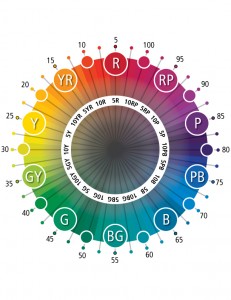
The circle has been known since before recorded history. Over time, circles have often represented associations such as a circle of friends or from the infamous “Meet the Parents” movie, the circle of trust. A.H. Munsell was not the first to apply Euclid’s element to color. As early as 1706, Sir Isaac Newton is thought to have developed the first hue circle in which he varied the size of each segment based on a calculation of wavelength.
Newton’s hue circle demonstrated additive mixing properties and the relationship between primary hues and their complementary color counterparts. The circle appeared to be more conducive to illustrating the relationship between colors and is still used in the modern day color wheel, which designers use to help choose a color scheme.
Taking the Hue Circle from 2D to 3D
Munsell took the hue circle a step further. As Munsell’s research evolved, a two-dimensional hue circle was only adequate to describe a single dimension of color, namely hue. Munsell turned to Euclidian geometry and architecture to more adequately describe the three-dimensional relationship between his three attributes of color—hue, color value and chroma.
Munsell saw similarities between the proportions and ratios explained in geometry and architecture with that of his color sphere. A visit in 1904 to the studio of artist, Jay Hambidge, helped confirm Munsell’s thinking on ratios and proportions as used in geometry and architecture. Hambidge’s early work in developing his 1926 theory of dynamic symmetry explained how proportions and ratios were the basis of design in nature and in Greek architecture and sculpture. Munsell writes in his diary that his work and that of Hambidge had some common points; that is “platonic solids all inscribe and exscribe a sphere” and there are “advantages of a circle as a point of departure.”
Human Visual System Distorts the Color Hue Circle
Munsell was the first to represent color in perceptually uniform dimensions by representing his three attributes of color—hue, value and chroma—in a three-dimensional color space. His later work, measuring human subjects’ response to color, continued to support his use of a three-dimensional color solid; however, the shape was less uniform since it was based on human visual perception. So although the hue circle or color wheel is still an effective way to represent color relationships, when it comes to visual perception and three-dimensional color space, the circle is somewhat distorted. Munsell books of color reflect the visual perception of color, making them and effective tool for color communications.
Learn more about the Munsell hue circle and how the hue circle can help you effectively communicate color.
References:
A. H. Munsell Color Diary, 1908-1918, Volume A Part 8. Courtesy of Rochester Institute of Technology, Munsell Color Science Laboratory.



Can you purchase a copy of the Munsell hue circle?
Carol,
Yes you can certainly purchase several Munsell Color products right here at https://munsell.com/color-products/
Thank you for reaching out.
I am a k-12 art educator in a public school in New York. I’d like to purchase a color wheel for my classroom, and perhaps some other products.
Do you have educator prices?
(Why don’t the customary art supply catalogs even carry Munsell Color Wheels? I’ve been searching them all!)
Thank you for a prompt response. I wish I could afford many of the charts and models too, but I just really need a well made ten step color wheel.
Constance
Hi Constance,
Customer support will be emailing you directly to help you with your questions.
Thank you for helping to education the future generation about our color system!
[…] that match your value (how light or dark you are), your chroma (how clear or muted you are) and temperature (how warm or cool you are). Know your 3 characteristics and you are […]
[…] and travelling in all directions in the interstices of the space, it is apparent that hue (the quality by which we distinguish one color from another) orbits in circular steps, around a […]
[…] to the hue they were […]